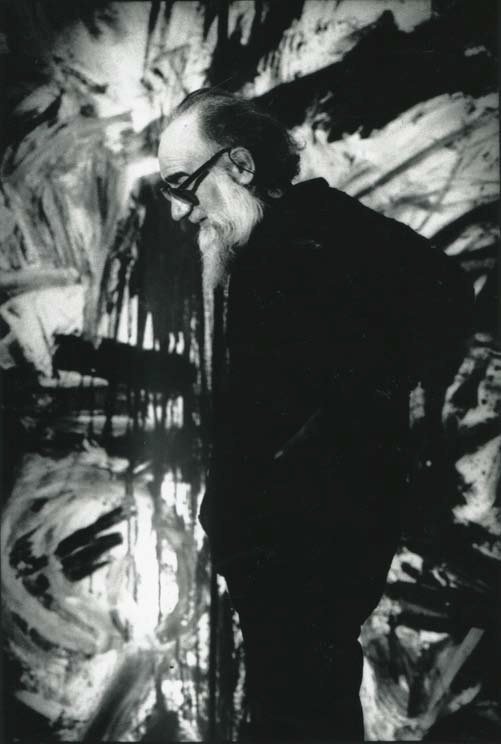Emilio Vedova
Born in Venice in 1919 into a family of workers and artisans, from the 1930s onwards Vedova began an intense activity as a self-taught artist. In 1942 he joined the anti-Novecento movement known as Corrente. An anti-Fascist, he participated to the Resistance from 1944 to 1945 and in 1946, he was one of the co-signers of the “Oltre Guernica” manifesto in Milan. In the same year he was one of the founders of the Nuova Secessione Italiana followed by the Fronte Nuovo delle Arti. In 1948 he made his debut in the Venice Biennale, the first of many appearances in this event: in 1952 an entire room was devoted to his work, in 1960 he was awarded the Grand Prize for Painting and in 1997 the Golden Lion award for Lifetime Achievement....Read more
Born in Venice in 1919 into a family of workers and artisans, from the 1930s onwards Vedova began an intense activity as a self-taught artist. In 1942 he joined the anti-Novecento movement known as Corrente. An anti-Fascist, he participated to the Resistance from 1944 to 1945 and in 1946, he was one of the co-signers of the “Oltre Guernica” manifesto in Milan. In the same year he was one of the founders of the Nuova Secessione Italiana followed by the Fronte Nuovo delle Arti. In 1948 he made his debut in the Venice Biennale, the first of many appearances in this event: in 1952 an entire room was devoted to his work, in 1960 he was awarded the Grand Prize for Painting and in 1997 the Golden Lion award for Lifetime Achievement. In the early 1950s he created the celebrated cycles of works: Scontro di situazioni, ciclo della Protesta, ciclo della Natura. In 1954, at the São Paolo Art Biennial he won a prize that would allow him to spend three months in Brazil, where he encountered a hard reality that would leave its mark on him. In 1961 he designed the sets and costumes for Luigi Nono’s Intolleranza ’60; in 1984 he would work with the composer again on Prometeo. From 1961 onwards he worked on his Plurimi, creating the Venetian series followed by works made from 1963 to 1964 in Berlin including the seven pieces forming the Absurdes Berliner Tagebuch ’64 presented at the 1964 Kassel documenta, where he showed in many occasions. From 1965 to 1967 he worked on Percorso/Plurimo/Luce for the Montreal Expo. He carried out intense teaching activities in various American universities followed by the Sommerakademie in Salzburg and the Academy of Venice. His artistic career was characterized by a constant desire to explore and innovate. In the 1970s he created the Plurimi/Binari in the Lacerazione and Carnevali cycles followed by the vast cycles of “teleri” (big canvases) and his Dischi, Tondi, Oltre and ...in continuum works. His last solo exhibitions included the major retrospective held at Castello di Rivoli (1998) and, after his death in 2006, the shows at Rome’s Galleria Nazionale d’Arte Moderna travelled to the Berlinische Galerie and at Milan’s Palazzo Reale, inaugureted in December 2019.
Read less
Emilio Vedova at Royal Academy of Art, London, 1989
© Fondazione Emilio e Annabianca Vedova - Ph. Fabrizio Gazzarri, Milano


